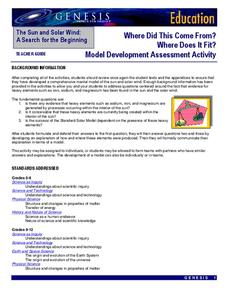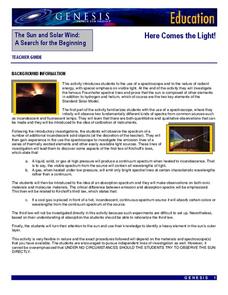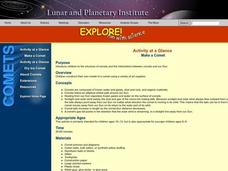NASA
Model Development Assessment Activity
Time to show off what they've learned! The final lesson in the series of six asks young scholars to process their learning from the previous lessons. They identify possible elements of the sun as well as a possible origin.
NASA
Here Comes the Light!
Look beyond the light! An engaging activity introduces young scholars to the application of a spectroscope. The lesson is the fifth in a series of six and focuses on the analysis of the elements of the sun.
Curated OER
Cooler in the Shadows
Students explore Earth science by creating a scale model in class. In this shadow instructional activity, students research the impact the sun has on Earth shadows and complete a space science worksheet. Students create models of the Sun...
Curated OER
The Sun in Our Lives
Third graders identify the different parts of the sun. In this astronomy instructional activity, 3rd graders examine how the sun's energy drive life processes on Earth. They construct a model of a solar system using large rolls of toilet...
Curated OER
Earth's Orbit Lesson
Tenth graders devise a computational model to explore how the orbit of the Earth might change if its velocity were different. Using accurately recorded data, 10th graders defend a scientific argument.
Curated OER
Star Wars Activity
Pupils investigate radiant energy by completing discrepant events and identify various temperature changes through absorption and how radiant energy can be used for solar panels. They experiment with different color fabrics in order to...
Curated OER
Phases of the Moon
Sixth graders learn that the moon orbits the Earth in a predictable cycle. Each learner engages in a two-week observation of the moon. They sketch its appearance, and take note of its position in relation to objects in their yard. Some...
Curated OER
What's the Frequency, Roy G. Biv?
Introduce starting space scientists to the electromagnetic spectrum, expecially the portion of visible light. Teach them about wavelength and frequesncy. Then give them a roll of adding machine tape and a manila folder to make a...
Curated OER
Identifying Ozone Variations over Different Locations
Learners analyze ozone data. In this atmosphere lesson, students will use a NASA resource to gather data for different regions of the Earth. Learners will then create a graph for their data and answer related questions.
Curated OER
Can Photosynthesis Occur at Saturn?
Young scholars identify the different requirements for photosynthesis to take place. In this space science lesson, students simulate conditions in Saturn to investigate if photosynthesis is possible there. They use data and observations...
Curated OER
Seasonal cycles
Young scholars understand that the rotation of the Earth is responsible for the seasons. For this seasonal cycles lesson, students learn how the rotation of the Earth affects the seasons. Young scholars answer questions about the...
Curated OER
Meteorites
Students model how meteors fall to the surface of planets. In this space science lesson plan, students identify different types of meteorites using an interactive online website. They investigate the relationship between a meteorite's...
Curated OER
Greenhouse Effect: Pop Bottle Experiment
Students explore global warming by conducting a weather experiment. In this greenhouse gas lesson, students define the greenhouse effect and the impact on our ozone layer. Students utilize a soda pop bottle, floodlight bulb, thermometers...
Curated OER
Hello Sun, Goodnight Moon
Students become familiar with different times around the world through the reading of 9 O'clock Lullaby. In this Earth, sun, moon lesson, students recognize the movement of the Earth and the relationship to the sun and the moon. ...
NASA
The Invisible Sun: How Hot Is It?
It's getting hot in here! The first in a series of six lessons has learners model nuclear fusion with a simple lab investigation. Groups collect data and analyze results, comparing their models to the actual process along the way.
NASA
Analyzing Tiny Samples Using a Search for the Beginning Mass Spectrometry
Teach the basics of mass spectrometry with a hands-on lesson. The fourth in a series of six lessons explores how mass spectrometry measures the ionic composition of an element. Learners then compare and contrast relative abundance and...
PBS
Inspector Detector
How do spacecraft detect magnetic fields? The fourth installment of a five-part unit has learners develop a device with magnets that allows for the detection of magnetic fields. They use a map of an imaginary planet to try out their...
Curated OER
Make a Comet
Students construct their own model of a comet using a variety of art supplies by reviewing pictures and diagrams of comets. They examine the structure of comets and the interactions between comets and our Sun.
Curated OER
Exploring the Night Sky: Fall/Winter
Students explain how moon phases occur. They explain three ways that the night sky has been used through history. Students locate some of the constellations in the night sky. They discuss stories and myths surrounding stars.
Curated OER
Seasonal CEENBoT
Students simulate the Earth's revolution around the sun using CEENBoT. In this earth science lesson students calculate the Earth's distance in AU and it's speed of revolution. They explain how the Earth's movement cause seasonal variation.
Curated OER
Meteors
Young scholars identify the different types of meteorite using an interactive website. In this earth science instructional activity, students simulate how meteors crash on a surface. They relate meteor size to crater size.
Curated OER
Wax On, Wane Off! the Different Views of the Moon
Students create a three-dimensional model of the Earth and Moon to show the different phases of the moon as they appear on Earth. In small groups, they draw a diagram for a phase, set up the model in the drawn positions then test it with...
Curated OER
Using Mathematic Models to Investigate Planitary Habitablity
Students examine how the sun's intensity affects the temperature on various planets. They determine whether or not these planets could be habitable. Finally, they factor in the average albedo of the planets to determine whether or not...
Curated OER
Sea Ice and Satellites
Students study satellites and satellite images using Google Earth. In this satellite lesson, students discuss satellites and how they work. Students watch a demonstration of how satellites work and learn what they are used for. Students...
Other popular searches
- Solar Energy Worksheets
- Free Solar Energy
- Daily Solar Radiation
- Earth's Solar Energy
- Solar Energy Projects
- Social Studies Solar Power
- Solar Power Book
- Solar Power Build Panels
- Solar Power Cooker
- Solar Power Environment
- Solar Energy Math
- House Designs Solar Power

























